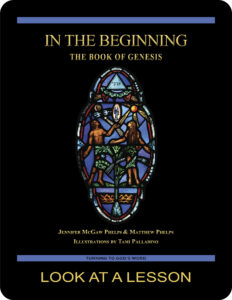 In the Beginning:
In the Beginning:
The Book of Genesis
Lesson 1 And God Said, Let There Be Light
the book of Genesis 1:1—2:3
Revised Standard Version Catholic Edition (RSVCE)*
New American Bible Revised Edition (NABRE)*
Catechism of the Catholic Church
Aperuit Illis (Instituting the Sunday of the Word of God)
ex libris (in our library)
cross references in the book of Genesis
Tami Palladino’s visual-meditation journal
next lesson: It Is Not Good That the Man Should Be Alone
This material coordinates with Lesson 1 on pages 4–11 in the study book In the Beginning: The Book of Genesis.
“And God saw everything that he had made, and behold, it was very good. And there was evening and there was morning, a sixth day. Thus the heavens and the earth were finished, and all the host of them. And on the seventh day God finished his work which he had done, and he rested on the seventh day from all his work which he had done.”—the book of Genesis 1:31—2:2
welcome to our in-depth study of the book of Genesis
We invite interested groups and individuals to check out the sample first lesson from this 28-lesson  Turning to God’s Word Catholic Bible study.
Turning to God’s Word Catholic Bible study.  These online study pages link to our free lesson video overviews as well as to a list of cross references in the biblical text. Other study aids include maps, charts, illustrations, additional commentary, and prayers based on the primary Scripture in each lesson. In the Beginning: The Book of Genesis has been granted an imprimatur and can be purchased from our website shop. If you have a Bible-study question or comment, click on one of the “ask us your question” or “what do you think” buttons on any online study page.
These online study pages link to our free lesson video overviews as well as to a list of cross references in the biblical text. Other study aids include maps, charts, illustrations, additional commentary, and prayers based on the primary Scripture in each lesson. In the Beginning: The Book of Genesis has been granted an imprimatur and can be purchased from our website shop. If you have a Bible-study question or comment, click on one of the “ask us your question” or “what do you think” buttons on any online study page.
every Turning to God’s Word Bible study carries an imprimatur
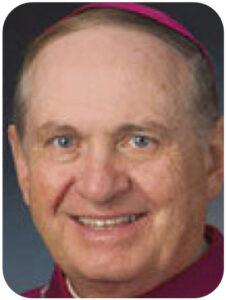 In the Beginning: The Book of Genesis was granted an imprimatur by
In the Beginning: The Book of Genesis was granted an imprimatur by  the Most Reverend Richard E. Pates, (left), bishop emeritus of the Diocese of Des Moines, on July 13, 2016; the censor librorum for the Diocese of Des Moines, the Very Reverend Aquinas Nichols, granted the nihil obstat. These are official declarations that a book or pamphlet is free of
the Most Reverend Richard E. Pates, (left), bishop emeritus of the Diocese of Des Moines, on July 13, 2016; the censor librorum for the Diocese of Des Moines, the Very Reverend Aquinas Nichols, granted the nihil obstat. These are official declarations that a book or pamphlet is free of  doctrinal or moral error. There’s no implication that those who’ve granted the imprimatur and nihil obstat agree with the contents, opinions, or statements expressed in the work. All Turning to God’s Word Catholic Bible studies are submitted to the Church before publication. Visit the archives of Lost in Translation to read more about the Latin terms imprimatur & nihil obstat. Turning to God’s Word Catholic Bible studies written after 2020 are being submitted to the Most Reverend William M. Joensen, Ph.D. (right), bishop of the Diocese of Des Moines.
doctrinal or moral error. There’s no implication that those who’ve granted the imprimatur and nihil obstat agree with the contents, opinions, or statements expressed in the work. All Turning to God’s Word Catholic Bible studies are submitted to the Church before publication. Visit the archives of Lost in Translation to read more about the Latin terms imprimatur & nihil obstat. Turning to God’s Word Catholic Bible studies written after 2020 are being submitted to the Most Reverend William M. Joensen, Ph.D. (right), bishop of the Diocese of Des Moines.
the popes inspire us—serious Catholics study the Word of God
In his apostolic letter Aperuit Illis (Instituting the Sunday of the Word of God) issued motu proprio (of his  own accord), Pope Francis established the Third Sunday in Ordinary Time to be devoted to the celebration, study, and dissemination of the Word of God. The Holy Father’s apostolic letter was published on September 30, 2019, the feast of St. Jerome and the 1600th anniversary of the saint’s death. St. Jerome, who translated the Latin
own accord), Pope Francis established the Third Sunday in Ordinary Time to be devoted to the celebration, study, and dissemination of the Word of God. The Holy Father’s apostolic letter was published on September 30, 2019, the feast of St. Jerome and the 1600th anniversary of the saint’s death. St. Jerome, who translated the Latin 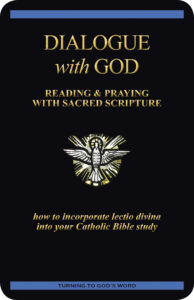 Vulgate Bible from Greek and Hebrew manuscripts, is famous for saying: “Ignorance of Scripture is ignorance of Christ,” and he’s the patron of translators and librarians. In Aperuit Illis, the Holy Father calls attention to the sacramental nature of the Word of God, pointing to the unbreakable bond between Sacred Scripture and the Eucharist. In 2025, the Church will celebrate the Word of God on Sunday, January 26. We’ve posted a free digital version of Dialogue with God: Reading & Praying with Sacred Scripture, our guide to incorporating the Church’s traditional practice of lectio divina (sacred reading) into regular Bible study.
Vulgate Bible from Greek and Hebrew manuscripts, is famous for saying: “Ignorance of Scripture is ignorance of Christ,” and he’s the patron of translators and librarians. In Aperuit Illis, the Holy Father calls attention to the sacramental nature of the Word of God, pointing to the unbreakable bond between Sacred Scripture and the Eucharist. In 2025, the Church will celebrate the Word of God on Sunday, January 26. We’ve posted a free digital version of Dialogue with God: Reading & Praying with Sacred Scripture, our guide to incorporating the Church’s traditional practice of lectio divina (sacred reading) into regular Bible study.
read more Church documents
Find links to magisterial documents referred to in Turning to God’s Word Catholic Bible  studies, including Aperuit Illis (Instituting the Sunday of the Word of God), at ex libris—magisterial documents. The page lists significant recent encyclicals as well as a number of historical Church documents.
studies, including Aperuit Illis (Instituting the Sunday of the Word of God), at ex libris—magisterial documents. The page lists significant recent encyclicals as well as a number of historical Church documents.
a few reminders about Turning to God’s Word Bible studies
The most distinguishing feature of our Bible studies is that they’re Catholic. Each one has been granted an imprimatur, which means that a bishop has read the work and found nothing contrary to Church teaching on morals or faith. Note that the imprimatur makes no claim that a work is equivalent to Church teaching, simply that it isn’t opposed to what the Church teaches. Practically speaking, this means that you don’t have to accept Turning to God’s Word interpretations of Scripture, only that choosing to do so doesn’t amount to heresy. Choosing not to accept conclusions of a work that’s been granted an imprimatur doesn’t immediately plunge you into heretical territory, but choosing not to accept Church teaching related to those conclusions does.
read the Catechism—how to avoid heresy
The imprimatur reinforces and validates the claim that Turning to God’s Word Bible studies are Catholic. All participants have a right to expect that discussions about our Bible studies will focus on Catholic teaching. That doesn’t mean that someone won’t occasionally have a question about Church teaching. Not knowing what the Church teaches about a particular issue isn’t heretical. Asking a question about Church teaching isn’t heretical. Failing to understand Church teaching isn’t heretical. Insisting that Church teaching is wrong is.
 Most people who begin to study the book of Genesis are caught off guard by how many challenging theological ideas are found in Scripture. There are a surprising number of things many Catholics believe to be Church teaching that actually are not. In this study, we attempt to present Scripture and Church teaching related to the book of Genesis as unambiguously as possible. When in doubt, you can refer to the Catechism of the Catholic Church or talk with your parish priest about any doctrine that remains unclear.
Most people who begin to study the book of Genesis are caught off guard by how many challenging theological ideas are found in Scripture. There are a surprising number of things many Catholics believe to be Church teaching that actually are not. In this study, we attempt to present Scripture and Church teaching related to the book of Genesis as unambiguously as possible. When in doubt, you can refer to the Catechism of the Catholic Church or talk with your parish priest about any doctrine that remains unclear.
If a Church teaching seems particularly unsettling even after studying the Catechism and speaking with someone who’s knowledgeable regarding Catholic doctrine, you might want to examine whether there might be a personal or emotional reason why you’re having difficulty. Pray for God’s guidance and be open to receiving a different answer than you anticipated, possibly at a later time than you expected or hoped.
be respectful of the others in your group
Keep in mind that most people in your discussion group are there for a Catholic interpretation of Scripture. People from other faith backgrounds are welcome, but the focus of any Turning to God’s Word study always is going to be Catholic in nature. The following opening prayer emphasizes maintaining mutual respect amid differences of opinion:
Heavenly Father, send forth your Spirit to enlighten our minds
and dispose our hearts to accept your truth.
Help us to listen to one another with openness and honesty,
eager to learn from the talents and intuitions that you have given each of us.
Never let differences of opinion diminish our mutual esteem and love.
May we leave this meeting with more knowledge and love for you and your Son.
In the unity of the Holy Spirit. Amen.
You can find other opening prayers on our website. We especially like the following:
Lord Jesus, you promised to send your Holy Spirit to teach us all things.
As we read and study your word today,
allow it to touch our hearts and change our lives. Amen.
WHAT DO YOU THINK about interpreting Scripture?
 The Church encourages Catholics to read and interpret Scripture on our own as long as we follow these two rules:
The Church encourages Catholics to read and interpret Scripture on our own as long as we follow these two rules:
1) Our interpretation can’t contradict anything else in Scripture.
2) Our interpretation can’t contradict Church teaching.
In order to comply, we need to know everything else that’s in the Bible as well as everything that the Church teaches. That’s a tall order, which is why each Turning to God’s Word Catholic Bible study is submitted to the Church for an imprimatur. The imprimatur for In the Beginning: The Book of Genesis is a guarantee that the Church finds nothing objectionable in the work. You’re free to agree with interpretations in In the Beginning: The Book of Genesis, but it’s not essential that you do so. There are many different interpretations in other commentaries, but very few of them carry an imprimatur. This doesn’t mean that they necessarily pose any problems in regard to Catholic doctrine or moral teaching, but there’s no Church guarantee that they don’t.
When considering opinions that haven’t been granted an imprimatur, don’t be afraid to ask questions. Our Bible studies address some common interpretations, but there are innumerable opinions floating around about the meaning of different passages in the Bible—including in the book of Genesis.
 ? Here’s the first question to ask about an opinion expressed in any commentary: How closely does it adhere to what we can read in the biblical text?
? Here’s the first question to ask about an opinion expressed in any commentary: How closely does it adhere to what we can read in the biblical text?
? Do viewpoints about the meaning of the Bible passages contradict anything else you already know from Scripture?
? Do they contradict anything from Church teaching? The Catechism of the Catholic Church addresses a large number of questions related to common Scripture interpretations.
the firmament of heaven
Illustrations by Turning to God’s Word co-founder Tami Palladino appear with some lessons in the study book In the Beginning: The Book of Genesis. A map or a genealogical chart is included with the other 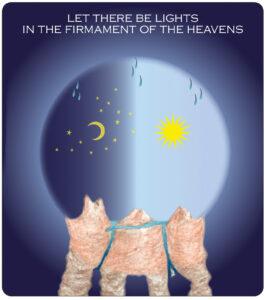 lessons. The
lessons. The  purpose of these visual elements is to help participants in our studies better understand some things described in the first book of the Old Testament. Tami’s illustration captures the gist of the ancient Hebrews’ understanding of the cosmos, which was quite different from the way we view the cosmos in the present day. Knowing this difference enhances our ability to grasp details in the first biblical account of Creation found in the opening chapter of the book of Genesis, and it will prove invaluable later in understanding what’s going on with Noah and the Flood. It also provides a strong context for understanding the way in which God works in each person. Click on the illustration (above right) to enlarge it. The original illustration is on page 9 in the study book In the Beginning: The Book of Genesis.
purpose of these visual elements is to help participants in our studies better understand some things described in the first book of the Old Testament. Tami’s illustration captures the gist of the ancient Hebrews’ understanding of the cosmos, which was quite different from the way we view the cosmos in the present day. Knowing this difference enhances our ability to grasp details in the first biblical account of Creation found in the opening chapter of the book of Genesis, and it will prove invaluable later in understanding what’s going on with Noah and the Flood. It also provides a strong context for understanding the way in which God works in each person. Click on the illustration (above right) to enlarge it. The original illustration is on page 9 in the study book In the Beginning: The Book of Genesis.
 start at the beginning (01:18:15)
start at the beginning (01:18:15)
In the video for Lesson 1, Turning to God’s Word author Matthew Phelps discusses  the opening of the book of Genesis. The word “genesis,” fittingly enough, means beginning. The very beginning of the Bible poses a special Scripture-study challenge addressed in this video: How can the Bible be true when right off the bat Scripture contradicts scientific explanations about the beginning of the world, using a type of literature called “myth,” which refers to a made-up story about how something came to be? On top of that, the book of Genesis opens with two Creation myths instead of
the opening of the book of Genesis. The word “genesis,” fittingly enough, means beginning. The very beginning of the Bible poses a special Scripture-study challenge addressed in this video: How can the Bible be true when right off the bat Scripture contradicts scientific explanations about the beginning of the world, using a type of literature called “myth,” which refers to a made-up story about how something came to be? On top of that, the book of Genesis opens with two Creation myths instead of  one—and they contradict each other. We’re challenged to think and pray about what kind of truth it is that the Bible contains. The first book of the Bible begins with an account of Creation that indicates God was in existence before all else. As puzzling as that is, it’s a basic tenet of Christianity. Another thing that men and women find difficult to understand is the idea of the presence of a void before God acted to create the world and everything in it. Matthew explains that it’s common for us to think about a void as total emptiness, but people in the ancient world thought about the abyss that existed at the beginning of time as a vast quantity of water. As we move forward in our study of the book of Genesis, we’ll see water having both positive and negative aspects—something essential for life as well as a source of death.
one—and they contradict each other. We’re challenged to think and pray about what kind of truth it is that the Bible contains. The first book of the Bible begins with an account of Creation that indicates God was in existence before all else. As puzzling as that is, it’s a basic tenet of Christianity. Another thing that men and women find difficult to understand is the idea of the presence of a void before God acted to create the world and everything in it. Matthew explains that it’s common for us to think about a void as total emptiness, but people in the ancient world thought about the abyss that existed at the beginning of time as a vast quantity of water. As we move forward in our study of the book of Genesis, we’ll see water having both positive and negative aspects—something essential for life as well as a source of death.
The Scripture ranges for the videos that accompany this Catholic Bible study from Turning to God’s Word match the Scripture ranges for the sets of questions in In the Beginning: The Book of Genesis. You can follow along as Turning to God’s Word author Matthew Phelps discusses Lesson 1, “And God Said, Let There Be Light,” on pages 4–11 in the study book.
how to think about the abyss & the firmament
The most important point to keep in mind is that the firmament consists of a space that God carves out of the dark, watery void. This firmament separates the waters above the earth from the waters below. The book of Genesis 1:8 records that God called this firmament heaven. The ancient Hebrews believed that the heavenly firmament was a globe-shaped space with water in the dark void all around it. They envisioned the earth to be a relatively flat plane located at the bottom of the globe-shaped space. The seas appear when God allows waters below the firmament to flow up into the spaces between the uneven masses of land. Rain occurs when God allows water above the firmament to fall down.
four corners of the earth
The pillars on which the earth rests were part of the ancient Hebrews’ idea of the cosmos, although there’s no mention of these in the book of Genesis. There’s a subtle hint, however, of the presence of four pillars supporting the earth in the book of Revelation 7:1: “After this I saw four angels standing at the four corners of the earth, holding back the four winds of the earth, that no wind might blow on earth or sea or against any tree.” Present-day Christians often marvel at this  ancient view of the cosmos. If the earth is believed to rest on pillars, we naturally wonder what those pillars then are resting on—this apparently was of little concern to the ancient Hebrews. The Turning to God’s Word Catholic Bible study The Revelation of Jesus Christ: The Faithful Witness provides an in-depth look at the New Testament Christian vision of heaven.
ancient view of the cosmos. If the earth is believed to rest on pillars, we naturally wonder what those pillars then are resting on—this apparently was of little concern to the ancient Hebrews. The Turning to God’s Word Catholic Bible study The Revelation of Jesus Christ: The Faithful Witness provides an in-depth look at the New Testament Christian vision of heaven.
gifts of time & space
In addition to creating a space for the world and everything in it, God also creates time by placing the sun and the moon in the firmament of the heavens to rule the day and the night. In the book of Genesis 1:16, the stars appear to be added almost as a playful afterthought. That the means of measuring day and night aren’t created until the fourth day raises a question about how God determined the beginning and ending of the first three days. This won’t be the only religious mystery we encounter in the book of Genesis—or elsewhere in Bible. In the case of the first Creation myth, it seems to reflect ancient thought that the sun, moon, and stars didn’t so much produce the light as exist within it.
 order & chaos—you could look this up in our archives
order & chaos—you could look this up in our archives
The biblical view of Creation differs from other ancient accounts in that God is viewed as Creator. To learn about the words “order” and “chaos” with respect to Creation, read Lost in Translation, an online column in which Turning to God’s Word author Matthew Phelps helps readers connect with ideas expressed in the original languages of the Scriptures. New Lost in Translation entries are posted on Mondays, and past entries are archived on our website. Contact us if you’d like to receive Lost in Translation by email every week.
WHAT DO YOU THINK about the work of the Most Holy Trinity?
One of the more interesting things about the account of Creation found in the first chapter of the book of Genesis is evidence of the presence of all three persons of the Most Holy Trinity.
 ? Can you locate the references to the Father, Son, and Spirit in the book of Genesis 1:1–3?
? Can you locate the references to the Father, Son, and Spirit in the book of Genesis 1:1–3?
? Where do you see evidence of each person of the Trinity present and creatively working in your life?
read the Catechism—let’s look at this idea of image & likeness
The book of Genesis 1:26 records that on the sixth day of Creation God said, “Let us make man in our own image, after our likeness … .” The use of both words “image” and “likeness” in this verse indicates that the biblical author doesn’t consider these words to be interchangeable, even though they commonly are used that way in our secular world. This should lead us to want to think about how the meanings of “image” and “likeness” may differ theologically. The one thing we can tell for certain from the biblical text is that it won’t do to define one word in terms of the other. We can’t decide that being made in the image of God means the same thing as saying that we’re like God; and we can’t decide that being like God means the same thing as saying that we’re in God’s image.
Fortunately, the Catechism of the Catholic Church offers some valuable information to help us. The key difference between “image” and “likeness” is explained in  paragraph 705. (It can be helpful to read paragraph 704 in the Catechism as well.)
paragraph 705. (It can be helpful to read paragraph 704 in the Catechism as well.)
705 Disfigured by sin and death, man remains “in the image of God,” in the image of the Son, but is deprived “of the glory of God,” of his “likeness.” The promise made to Abraham inaugurates the economy of salvation, at the culmination of which the Son himself will assume that “image” and restore it in the Father’s “likeness” by giving it again its Glory, the Spirit who is “the giver of life.”
a complex theological distinction
The theological distinction between “image” and “likeness” can be expressed somewhat simply, but this fairly complex idea is essential to understanding the roots of Christianity. Being made in God’s image means we’re made in the same form as God. Our flesh bears the imprint of God so that we display visible similarities to God. This is what it means to be created in God’s image. Likeness differs from image in that likeness refers to substance. When we behave the same way that God does, we’re behaving like God. Theologically speaking, likeness to God can be boiled down to being sinless.
It may help to think of image in terms of the image of a ruler imprinted on coins. No one would mistake a coin for the person whose image is on the coin. The image is incapable of exercising free will to make a decision or to take any action. The image has a purpose, however, which is to represent the absent ruler and to guarantee the worth or value of the coin itself. Men and women are given dominion over the earth to represent God. That humanity bears the image of God is an indication of the high value that God places on men and women. That God’s created men and women in his likeness means that God has created us to exercise our free will in order to take the same actions as God.
something to watch for as we move forward
At Creation, men and women bore both the image and the likeness of God. The first men and women were in the same form as God so they displayed visible similarities to God. They also were sinless like God, so they resembled God in substance as well as in form. When sin becomes a fact of life, men and women no longer are like God, even though we maintain the form of God and continue to display visible similarities. When humanity sins, that necessarily causes us to lose our likeness to God.
a connection to the New Testament
Consider what the Letter to the Philippians 2:6–11 has to say about Jesus being in the form (or the image) of God—and what that  passage means to Christians. The author of the Letter to the Hebrews reflects on Jesus’ human and divine natures to explain how salvation works. Learn more in Lesson 2 Like His Brethren in Every Respect in the Turning to God’s Word Catholic Bible study The Letter to the Hebrews: An Explanation of the Mechanism of Our Salvation.
passage means to Christians. The author of the Letter to the Hebrews reflects on Jesus’ human and divine natures to explain how salvation works. Learn more in Lesson 2 Like His Brethren in Every Respect in the Turning to God’s Word Catholic Bible study The Letter to the Hebrews: An Explanation of the Mechanism of Our Salvation.
there’s more than one biblical version of Creation
Many people overlook that there are two accounts of Creation at the beginning of the book of Genesis. These differ in several significant ways. We’ll begin comparing these in Lesson 2 of our study. Just because these two accounts are somewhat different doesn’t mean that one version is true and the other one is false. Both Creation accounts are included in the canon of Sacred Scripture. Our task moving forward will be to figure out how the two versions fit together to present a more complete picture of the truth about God and Creation than either account would provide if it were read alone. In a similar manner, the four Gospels differ from one another in many ways, yet we as Christians accept that each is true even though these accounts of Jesus’ life contain apparent contradictions.
more about C.S. Lewis’ understanding of myth
“Myth” on page 6 in In the Beginning: The Book of Genesis discusses the literary genre into which Scripture scholars place the two Creation accounts. You can read more about C.S. Lewis’ intriguing understanding of Jesus Christ as a “true myth” in the following article:
- C.S. Lewis and Tolkien on Myth and Knowledge, by Fr. Roger Peck in the April 2011 issue of “Faith” magazine
ex libris—large & small mysteries of the universe
If you like to ponder the mysteries of the world that God has created, you might enjoy reading the Pulitzer Prize-winning book, Pilgrim at Tinker Creek by Annie Dillard. A work of non- fiction, this
fiction, this 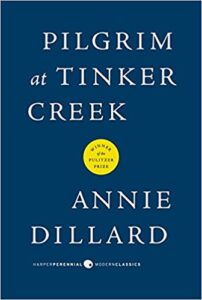 beautifully written book focuses on an immense number of scientific peculiarities found in the natural environment in and around a creek in Virginia. In these remarkable marvels of nature, the author sees undeniable evidence of God. This book can inspire readers to more closely examine similar natural evidence present in the everyday environments of our own lives. To read an excerpt or to learn more about books related to Scripture study, visit ex libris—main bookshelf.
beautifully written book focuses on an immense number of scientific peculiarities found in the natural environment in and around a creek in Virginia. In these remarkable marvels of nature, the author sees undeniable evidence of God. This book can inspire readers to more closely examine similar natural evidence present in the everyday environments of our own lives. To read an excerpt or to learn more about books related to Scripture study, visit ex libris—main bookshelf.
another video—one that could change the way you approach the Bible (40:44)
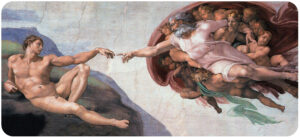 Even if you’re a veteran of Catholic Bible studies, we recommend that you watch an explanation of the practical benefits of approaching The Bible as the Living Word of God. This 40-minute video is distilled from a talk that Turning to God’s Word author Matthew Phelps gave at a summer Bible study retreat at Conception Abbey in Conception, Missouri. In this video, Matthew looks at how viewing Scripture as a living document can help us to develop a more intimate relationship with Jesus Christ. There are benefits in setting aside what we think we know about Scripture to approach the Bible with the goal of learning what new things God is saying to us. Matthew examines the principles of lectio divina, the traditional Catholic approach to reading and praying with Scripture that’s foundational for all Turning to God’s Word Bible studies.
Even if you’re a veteran of Catholic Bible studies, we recommend that you watch an explanation of the practical benefits of approaching The Bible as the Living Word of God. This 40-minute video is distilled from a talk that Turning to God’s Word author Matthew Phelps gave at a summer Bible study retreat at Conception Abbey in Conception, Missouri. In this video, Matthew looks at how viewing Scripture as a living document can help us to develop a more intimate relationship with Jesus Christ. There are benefits in setting aside what we think we know about Scripture to approach the Bible with the goal of learning what new things God is saying to us. Matthew examines the principles of lectio divina, the traditional Catholic approach to reading and praying with Scripture that’s foundational for all Turning to God’s Word Bible studies.
visual meditation is a form of prayer
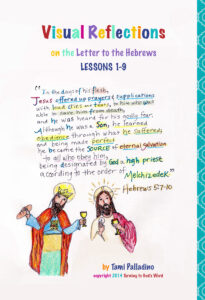 If you like to draw, consider illustrating your prayers for In the Beginning: The Book of Genesis. Check out the visual-meditation journal of
If you like to draw, consider illustrating your prayers for In the Beginning: The Book of Genesis. Check out the visual-meditation journal of Turning to God’s Word co-founder Tami Palladino, which she created to accompany another of our Catholic Bible studies, The Letter to the Hebrews: An Explanation of the Mechanism of Our Salvation. Tami also illustrated Sing a New Psalm: Communicating with God Through the Prayers of the Church—Volume I: Lauds & Vespers and The Revelation of Jesus Christ: The Faithful Witness, and some lessons in this Bible study and in You Shall Have No Other Gods: The Book of Exodus.
Turning to God’s Word co-founder Tami Palladino, which she created to accompany another of our Catholic Bible studies, The Letter to the Hebrews: An Explanation of the Mechanism of Our Salvation. Tami also illustrated Sing a New Psalm: Communicating with God Through the Prayers of the Church—Volume I: Lauds & Vespers and The Revelation of Jesus Christ: The Faithful Witness, and some lessons in this Bible study and in You Shall Have No Other Gods: The Book of Exodus.
Q&A—where to find some answers
Some people who are used to doing Bible studies from other publishers miss the answer keys included in those studies. One leader even admitted to us that she relied on answer keys so she didn’t have to spend time doing Bible study lessons herself. We sympathize with omnipresent time constraints, but we maintain that up-front answer keys provide people with a strong temptation to rely on someone else’s idea of what Scripture means instead of thinking more deeply about what God might be trying to say to them personally at that moment.
 Q: Why don’t Turning to God’s Word Catholic Bible studies provide any printed answer keys?
Q: Why don’t Turning to God’s Word Catholic Bible studies provide any printed answer keys?
A: The Turning to God’s Word method of Bible study depends on participants engaging with the biblical text for answers to their questions. All of the factual questions in the lessons can be answered from the Scriptures. Sidebars in the lessons contain material that may help explain some of the themes suggested by the biblical text. Most of our studies, including this one, feature videos with each lesson.
Outside commentaries can shed light on individual texts, but many commentaries examine Scripture passages out of context. Some may focus on an academic rather than a spiritual approach to the Bible. If you’re confused about anything in our studies or in any related outside commentaries, we encourage you to browse our website for more information.
The goal of all Turning to God’s Word Catholic Bible studies is to foster personal reflection leading to a more intimate relationship with Jesus. Consequently, each lesson contains  reflection questions, and these necessarily don’t have any “right” or “wrong” answers. If you’d like to share your thoughts about any of our studies or need clarification about a question, commentary, or video related to the lessons, contact us using the “ask us your question” or “what do you think” button on any online lesson page. Because others may have the same concern, we routinely turn questions and comments we receive into anonymous Q&A items and add them to the relevant online study pages.
reflection questions, and these necessarily don’t have any “right” or “wrong” answers. If you’d like to share your thoughts about any of our studies or need clarification about a question, commentary, or video related to the lessons, contact us using the “ask us your question” or “what do you think” button on any online lesson page. Because others may have the same concern, we routinely turn questions and comments we receive into anonymous Q&A items and add them to the relevant online study pages.
Q&A—three questions about Bible translations
We’re frequently asked what translation of the Bible is best. Sometimes we’re asked which translation is approved to be read at Catholic Masses. More infrequently we’re asked why we’ve chosen to reprint the Revised Standard Version Second Catholic Edition (RSV2CE) for the biblical text in our printed studies.
Q1: Which translation of the Bible is the best one for Catholics to read? 
A2: As far as which translation is “best,” we maintain that reading any translation of the Bible you have on hand is a great place to start. The old adage “every translator is a traitor” certainly applies to Scripture, but God’s basic message to his people can be found in any Bible. While there are English-language Bibles catering to a variety of special-interest Catholic groups, they generally reprint either a translation of the New American Bible Revised Edition (the NABRE) or a Catholic edition of the Revised Standard Version (the RSVCE or the RSV2CE), which are the Bibles read by most American Catholics. Both of these translations rely on archeological finds and scholarship that were unavailable in earlier centuries. Prior to the mid-1960s, most Catholics were familiar with the Douay-Rheims English translation, which was based on the Latin Vulgate. Originally translated by St. Jerome in the late 4th century, a version of the Vulgate has remained the official Latin translation of the Catholic Church since the 16th century. Prior to the mid-1960s, most Protestants read The King James Version.
As people become more interested in Scripture study, they also become more interested in reading the “right” Bible. Since very few of us are proficient in ancient languages, we’re forced to rely on the work of scholars who’ve spent years studying Hebrew, Greek, Aramaic, and Latin. In many cases, there simply isn’t an easy way to translate some of the original words and phrases of Scripture into English. The best advice we can offer is to choose an English translation that the Church has approved. The United States Conference of Catholic  Bishops (USCCB) offers guidelines. When questions arise, as they undoubtedly will, check out footnotes, commentaries, and other translations; talk to a knowledgeable priest; and—this part is most important—ask God to grant you increased understanding. You also can email us with your questions about Scripture. In many cases, Turning to God’s Word author Matthew Phelps’ background in classical languages proves helpful. We frequently rely on him to shed some light on the linguistics involved in difficult passages
Bishops (USCCB) offers guidelines. When questions arise, as they undoubtedly will, check out footnotes, commentaries, and other translations; talk to a knowledgeable priest; and—this part is most important—ask God to grant you increased understanding. You also can email us with your questions about Scripture. In many cases, Turning to God’s Word author Matthew Phelps’ background in classical languages proves helpful. We frequently rely on him to shed some light on the linguistics involved in difficult passages
Q2: I’m having trouble locating the same Bible that I hear read at Mass. What translation is that?
A2: The Catholic Lectionary, a collection of biblical texts approved for liturgical use, isn’t the same as a Bible. The English-language lectionary used in the United States is primarily based on a 1970 translation. A close English translation outside the lectionary is the New American Bible Revised Edition (NABRE). The United States Conference of Catholic Bishops (USCCB) currently is working on a liturgical Bible based on the NABRE translation.
Q3: Why has Turning to God’s Word chosen to reprint biblical text from the Revised Standard Version Second Catholic Edition (RSV2CE) instead of the New American Bible Revised Edition (NABRE)?
A3: We currently use the Revised Standard Version Second Catholic Edition (RSV2CE) as our primary biblical translation in our printed studies because scholars consider it to be a more faithful word-for-word translation than many other translations. Pope Benedict XVI quotes from the RSV2CE in his three-volume book, Jesus of Nazareth. The RSVCE is the Bible translation used in English translations of the Catechism of the Catholic Church. The RSV2CE varies only slightly from the earlier RSVCE, which we link to on our online study pages. Any discrepancies between the RSV2CE and the RSVCE are pointed out on the online study pages. Turning to God’s Word cites The Abbey Psalms and Canticles in references to the Psalms in all of our printed studies.
pray with the Psalms—intensely emotional prayers
Although some scholars question David’s authorship of the Psalms, it remains indisputable that many of the Psalms address  themes related to events that occurred during the period when David ruled over the descendants of Jacob. Reading and praying with the Psalms offers insight into the minds and hearts of people who lived during the time of David—and long afterward as well. These prayers express universal human feelings every bit as relevant to us in the present day as when the Psalms first were composed.
themes related to events that occurred during the period when David ruled over the descendants of Jacob. Reading and praying with the Psalms offers insight into the minds and hearts of people who lived during the time of David—and long afterward as well. These prayers express universal human feelings every bit as relevant to us in the present day as when the Psalms first were composed.
don’t get confused—Psalms numbering varies
Numbering of many of the Psalms and their verses varies from one translation to another. Parallel  numbering for commonly used Catholic Bibles is noted in the citations index in the back of the study book In the Beginning: The Book of Genesis and also on the back pages of the sample lesson. For more information about why the numbering varies in some translations, see the Q&A on the online study page for Lesson 1 Set a Guard on My Mouth in Sing a New Psalm: Communicating with God Through the Prayers of the Church—Volume I: Lauds & Vespers.
numbering for commonly used Catholic Bibles is noted in the citations index in the back of the study book In the Beginning: The Book of Genesis and also on the back pages of the sample lesson. For more information about why the numbering varies in some translations, see the Q&A on the online study page for Lesson 1 Set a Guard on My Mouth in Sing a New Psalm: Communicating with God Through the Prayers of the Church—Volume I: Lauds & Vespers.
t he best Catholic commentary about Scripture
he best Catholic commentary about Scripture
To find out more about how Church teaching is supported by Scripture passages in the study book In the Beginning: The Book of Genesis, check out the Index of Citations in the Catechism of the Catholic Church. Links (Revised Standard Version Catholic Edition [RSVCE*]) to the primary Scripture passages in the lesson and relevant paragraphs in the Catechism are provided here. Not every passage in the biblical text for this Catholic study is referenced in a Catechism paragraph, however.
the book of Genesis 1:1—paragraphs 268, 279, 280, 290
the book of Genesis 1:1—2:4—paragraph 337
the book of Genesis 1:2—paragraphs 243, 703, 1218
the book of Genesis 1:2–3—paragraph 292
the book of Genesis 1:3—paragraph 298
the book of Genesis 1:4—paragraph 299
the book of Genesis 1:10—paragraph 299
the book of Genesis 1:12—paragraph 299
the book of Genesis 1:14—paragraph 347
the book of Genesis 1:18—paragraph 299
the book of Genesis 1:21—paragraph 299
the book of Genesis 1:26—paragraphs 36, 225, 299, 343, 2501, 2809
the book of Genesis 1:26–27—paragraphs 355, 383, 1604, 2331
the book of Genesis 1:26–28—paragraph 307
the book of Genesis 1:26–29—paragraph 2402
the book of Genesis 1:27—paragraphs 355, 383, 1604, 2331
the book of Genesis 1:28—paragraphs 372, 373, 1604, 1607, 1652, 2331, 2427
the book of Genesis 1:28–31—paragraph 2415
the book of Genesis 1:31—paragraphs 299, 1604
the book of Genesis 2:1–3—paragraph 345
the book of Genesis 2:2—paragraphs 314, 2184
to learn more, read more Scripture
If you’re having difficulty with a particular passage of Scripture, it can be helpful to read the relevant  cross references—but looking these up can take time. To make that easier, we’ve compiled the cross references from the Revised Standard Version Second Catholic Edition (RSV2CE)—the translation that we reprint in our study books. That list can be found at the top of every online study page, and it includes links to cross references in the primary biblical text in the study book In the Beginning: The Book of Genesis.
cross references—but looking these up can take time. To make that easier, we’ve compiled the cross references from the Revised Standard Version Second Catholic Edition (RSV2CE)—the translation that we reprint in our study books. That list can be found at the top of every online study page, and it includes links to cross references in the primary biblical text in the study book In the Beginning: The Book of Genesis.
don’t forget about our indexes & extra online material

 If you’re trying to locate information about a specific Scripture passage, you can look it up in the index at the back of the study book or sample lesson. If you want to find a particular commentary, you can look up its title in the topics index. To learn more about another book of the Bible for which there’s a Turning to God’s Word study, visit the online study directories to read the commentaries and watch any accompanying videos. Finally, if you have a question or would like to make a comment about any of our studies, you can use one of the “ask us your question” or “what do you think” buttons to email our authors.
If you’re trying to locate information about a specific Scripture passage, you can look it up in the index at the back of the study book or sample lesson. If you want to find a particular commentary, you can look up its title in the topics index. To learn more about another book of the Bible for which there’s a Turning to God’s Word study, visit the online study directories to read the commentaries and watch any accompanying videos. Finally, if you have a question or would like to make a comment about any of our studies, you can use one of the “ask us your question” or “what do you think” buttons to email our authors.
ex libris—Church documents & books about religious topics
Link to magisterial documents referred to in our Bible studies at ex libris—magisterial documents.  This listing includes significant recent encyclicals as well as a number of historical Church documents. Recommended books related to Scripture study can be found at ex libris—main bookshelf.
This listing includes significant recent encyclicals as well as a number of historical Church documents. Recommended books related to Scripture study can be found at ex libris—main bookshelf.
memorize a favorite Bible verse (4:48)
Turning to God’s Word co-founder Tami Palladino has created a short video about the benefits of memorizing Bible verses. Choosing a passage that you find particularly meaningful will make the task easier. There are inspiring verses in every book of the Bible, but some people in our Turning to God’s Word Catholic Bible studies like to memorize a verse from their lesson every week. For more ideas, check out Tami’s video, Why Memorize Scripture? It’s less than five minutes long.
wondering how to pronounce some of these words?
The following link is to a reading from the New International Version (NIV) Bible. To listen, open the link and click on the audio icon above the printed text. Although not taken from the translations used in our study materials, the NIV reading provides an audio guide to pronunciation of words in this lesson’s primary biblical text. A close online version of the translation of the Bible used in Catholic liturgy in the United States as well as an audio guide for daily Mass readings for the current month can be found on the website of the United States Conference of Catholic Bishops (USCCB).
 close with Bible-based prayer related to this lesson
close with Bible-based prayer related to this lesson
Many of our Catholic study groups like to conclude their discussions with a prayer based on the scriptural focus of their lesson, and some participants include Scripture-specific prayer in their individual study. If you’re uncomfortable composing your own Bible-based prayers, you can follow our four easy steps. If you prefer, you can use the following prayer based on this lesson’s text from the book of Genesis.
O God, you created the world and all that’s in it
where nothing existed except a dark, formless void.
Foster in us a spirit of gratitude and the desire
to use wisely the gifts that you’ve given us
in order that we may be found worthy of the even greater gift
of eternal life made possible through your Son.
We ask this in the name of Jesus Christ, who was present
with you and the Spirit in the beginning. Amen.
Lesson 2 It Is Not Good That the Man Should Be Alone—the book of Genesis 2:4–25
you also may like our study of the Gospel According to John
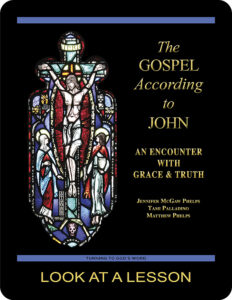 The Gospel According to John: An Encounter with Grace & Truth, a 25-lesson Catholic Bible study with an imprimatur, examines the Fourth Gospel’s view of Jesus Christ as the Son of God, with special emphasis on the institution of the sacraments of the Church as the means by which Christians are purified and made holy. This recently revised study includes maps and additional commentary, and takes a closer look at the way in which Jesus relates to individual men and women. Click on the book’s cover to view a sample lesson.
The Gospel According to John: An Encounter with Grace & Truth, a 25-lesson Catholic Bible study with an imprimatur, examines the Fourth Gospel’s view of Jesus Christ as the Son of God, with special emphasis on the institution of the sacraments of the Church as the means by which Christians are purified and made holy. This recently revised study includes maps and additional commentary, and takes a closer look at the way in which Jesus relates to individual men and women. Click on the book’s cover to view a sample lesson.
start a Turning to God’s Word Bible study
 Thank you for your interest in our study In the Beginning: The Book of Genesis.
Thank you for your interest in our study In the Beginning: The Book of Genesis.  Information about beginning a Turning to God’s Word Catholic Bible study can be found at start a Bible study. Tami, Matthew, and I are available to answer questions and offer support. Contact us if you’d like to start a Turning to God’s Word study or have your schedule listed with other TtGW study groups on our website. —Jennifer
Information about beginning a Turning to God’s Word Catholic Bible study can be found at start a Bible study. Tami, Matthew, and I are available to answer questions and offer support. Contact us if you’d like to start a Turning to God’s Word study or have your schedule listed with other TtGW study groups on our website. —Jennifer
*There are seven deuterocanonical books in the Old Testament—the Books of Tobit, Judith, Wisdom, Sirach, Baruch, and First and Second Maccabees, as well as some passages in the Books of Esther and Daniel. Protestants usually refer to these works as “apocryphal,” a word that means “outside the (Protestant) canon” because they’re excluded from most Protestant Bibles. The word “deuterocanonical” means “second canon”; Catholics use that word to refer to any section of the Catholic Old Testament for which there are no extant, or existing, Hebrew manuscripts. All of the deuterocanonical books appear in the Septuagint, the earliest remaining versions of which date to the 1st century B.C. This Greek translation of the Old Testament was in common use by Jews at the time of Jesus—but the same books aren’t found in existing Hebrew manuscripts, which aren’t as old as the oldest version of the Septuagint. Learn more by reading How Do Catholic & Protestant Bibles Differ?
Turning to God’s Word printed Bible studies use the 2006 Revised Standard Version Second Catholic Edition (RSV2CE) translation for all Scripture references except those to the Psalms, which are taken from The Abbey Psalms and Canticles, prepared by the Benedictine monks of Conception Abbey and published in 2020 by the United States Conference of Catholic Bishops (USCCB). All Scripture links for the online study pages for In the Beginning: The Book of Genesis are to the 1966 Revised Standard Version Catholic Edition (RSVCE) translation. The New International Version (NIV) audio recordings follow the same chapter and verse numbering as the RSV Catholic translations, but the NIV translation doesn’t include the deuterocanonical books and passages.
The 1966 RSVCE uses archaic pronouns and verb forms such as “thee,” “thou,” “didst” in the Psalms and in direct quotations attributed to God. The 2006 RSV2CE replaces those with more accessible English. The few significant translation changes in the RSV2CE include rendering almah as “virgin” in the Book of Isaiah 7:14 and restoring the term “begotten” in the Gospel According to John 3:16.
Numbering varies for some passages in this Bible study. Turning to God’s Word studies (print and digital) follow the numbering in the Revised Standard Version Catholic translations (RSV2CE and RSVCE). Discrepancies in the New American Bible Revised Edition (NABRE) are noted in the Index of Scripture Citations in the study book and the online sample.
 You can learn more about the Psalms by viewing a sample lesson from the Turning to God’s Word Catholic Bible study Sing a New Psalm: Communicating with God Through the Prayers of the Church—Volume I: Lauds & Vespers. The second part of that study, Sing a New Psalm: Communicating with God Through the Prayers of the Church—Volume II: Vigils, Day Prayer & Compline, is scheduled for publication in 2025. Some verse numbers may vary in different translations of the Psalms.
You can learn more about the Psalms by viewing a sample lesson from the Turning to God’s Word Catholic Bible study Sing a New Psalm: Communicating with God Through the Prayers of the Church—Volume I: Lauds & Vespers. The second part of that study, Sing a New Psalm: Communicating with God Through the Prayers of the Church—Volume II: Vigils, Day Prayer & Compline, is scheduled for publication in 2025. Some verse numbers may vary in different translations of the Psalms.
